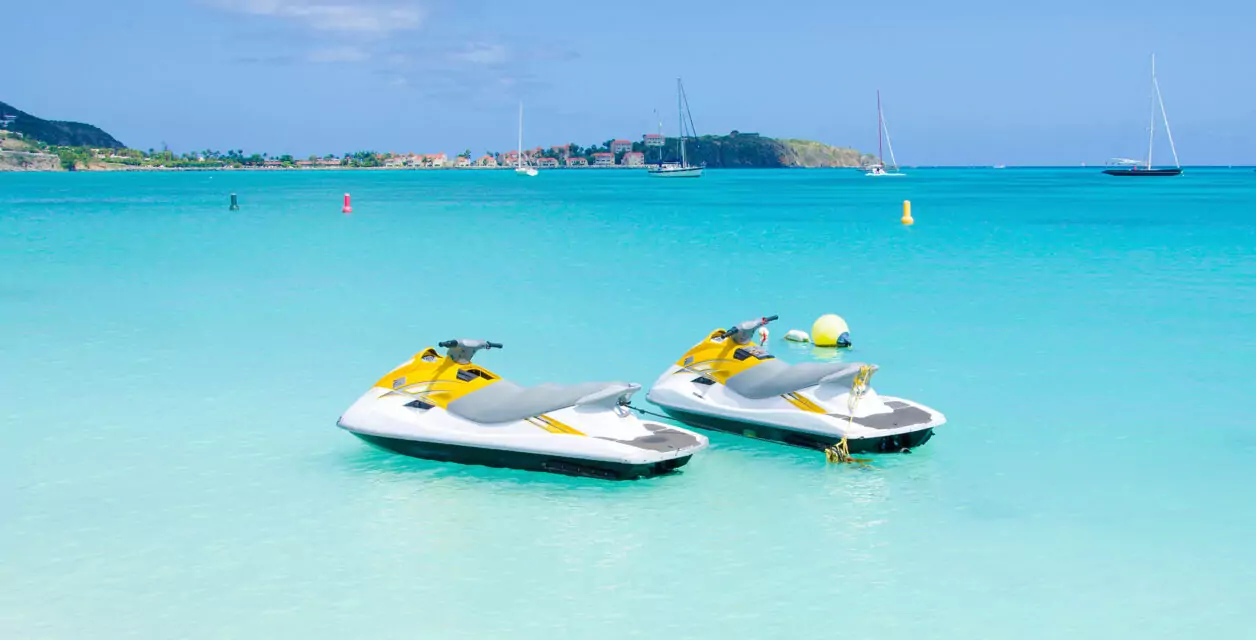Have you encountered a situation where a customer damaged your rented jet ski and you were not sure how to fix it? Watersport Operators, and WaveRez partners specifically, have shared a variety of problems they’ve experienced, as well as proposed solutions. While most of this information is available online, we’ve taken the time to compile it in one place. So stick around to learn 5 common PWC damages and ways to fix the issue on the spot. DIY!
Before we begin, here are the preliminary things to check on your personal watercraft:
- It starts.
- It’s regularly maintained.
- Proper de-winterization is complete.
- Battery functions in the right way.
If you’ve covered the basics for your Jet Ski, WaveRunner, or Sea-Doo, then stick around to learn what might be shortening your PWC’s lifespan. Each damage scenario will address the following:
- How to fix it
- What tools do you need
- How much time will it take to fix the issue
- Why you need to fix it
- What are the consequences of not fixing it
- What happens if you don’t address it in a timely manner
- How urgently it needs to be fixed
- How to maintain it to make sure it does not happen again
#1: Jet Ski Sucked in Some Sand
This example was shared by WaveRez CEO, Greg Fisher, in one of his podcast episodes while sharing his experience dealing with difficult customers during his time as a watersport business owner. When customers drive jet skis in water that is too shallow causing it to suck in sand, a variety of issues can occur and they should be addressed as soon as possible.
Possible damaged jet ski parts: Jet Pump, Hull, Motor
Items for fixing this issue: Garden Hose & Flushing Adapter
Time needed for fixing the issue: Check your PWC owner’s manual, as it varies from model to model
Repair Instructions:
- Upon return, flush the engine to clear passageways & let the engine just cool down (from overheating).
- Check out Motor Cleaning Guidelines, Jet Pump Cleaning Guidelines, and Hull Cleaning Guidelines.
Consequences of not fixing the issue timely:
- Sand and rocks scratch the hull
- Engine’s lifespan gets shortened significantly
- Exhausting and cooling systems are at risk
Ways for preventing this issue from happening again:
- Install the large capacity inline water filter to the cooling system. This method can only work if your jet pump is not ingesting a lot of sand; otherwise, the inline water filter will clog too quickly.
- Avoid beaching your jet ski, especially running them onto the beach like in this video.
- Turn off the engine when the water is less than 3 feet deep.
#2: Jet Ski Hits Another Vessel or Dock
This incident is not only dangerous for your jet ski, but also your customers, including broken bones, fractured ankles, and others. That is why it’s essential to conduct injury prevention briefings before customers hop on their jet skis and start enjoying their ride. Nonetheless, let’s take a look at what might happen to your PWC when this type of accident occurs.
Possible damaged jet ski parts: Fiberglass and gelcoat that make a firm surface when combined
Items for fixing this issue
Time needed for fixing the issue: Around 2 hours
Repair Instructions
Consequences of not fixing the issue timely:
- Fiberglass protects from water dripping
- Gelcoat protects from scratches and moisture damage
Ways for preventing this issue from happening again:
Your briefings with customers before the start of the rental should address the following points:
- Accidents can happen super fast on personal watercraft, which is why:
- Your customers should not allow other skis to get close to them — they should constantly be on the lookout for people driving recklessly on the water.
- Advise your customers not to get too close to other jet skis or boats.
- If your customers come with kids, you must be very cautious and ensure you check the local laws in your state about allowing minors to operate your rented watercraft. For example, in Florida, where WaveRez HQ is located:
- A person must be at least 14 years of age to operate a personal watercraft.
- A person must be at least 18 years of age to rent a personal watercraft.
It is vital to indicate applicable regulations to your customers before their rental begins and to stress safety requirements with younger guests.
- Advise your customers to wear sunglasses or goggles throughout the whole ride, especially at high speeds. Our partners tell us that this simple safety precaution helps their customers avoid severe eye injuries from impacts with bugs.
#3: WaveRunner Gets Flipped
Sometimes your customers, especially those who are new to jet ski driving, can cause your WaveRunner to flip over. Something as simple as a passenger who shifts their weight incorrectly in a turn is sufficient to cause your PWC to capsize. A sudden wave can also easily turn your jet ski over if there is excessive weight on the ski. Whatever the reason might be, it is crucial to address it ASAP if you don’t want your PWC to die, especially if you can’t replace it. The 2021 season looks promising so far in the southern U.S., so you don’t want to miss an opportunity not to catch the wave of leads.
Possible damaged jet ski parts: Engine Crank Case and Hull
Items for fixing this issue: Starting Fluid, and/or Mechanic (optional)
Time needed for fixing the issue: Check your PWC owner’s manual, as it varies from model to model
Repair Instructions:
- Your customers need to make sure they are not injured.
- Turn off the engine if it is still running.
- Flip your PWC back over so that the exhaust hits the water last; refer to the diagram on the back of your PWC for more info.
- Once the customers return their rentals, check out if you can start your jet ski. If they don’t start, then it is likely that water has gotten into the engine, which means it was hydro locked and now needs to be dried out. The easiest thing to do is get your mechanic involved to fix the issue for you, but if you want to do it yourself, then refer to these guidelines.
Consequence of not fixing the issue timely: ‘
If you don’t check on the equipment’s engine before the next rental starts, it can cause damage to the crank case damage, in which case you would have to replace it or, in the worse case scenario, get new equipment.
Ways for preventing this issue from happening again:
Your briefings with customers before the start of the rental should address the following points:
- Instruct your customers on weighing techniques when it comes to turns before their rentals start.
- Let them get some practice with flipping and reboarding before their rentals start.
- Make sure your customers attach the kill switch into their life jacket. Luther’s Pontoon, a WaveRez partner, asks their customers to do it in the company’s WaveRunner safety video. This helps them make sure the jet ski engine stops running if a person falls off.
#4: Jet Ski Sucks Up a Rope
Some inexperienced jet ski drivers drive over a rope, and it then wraps around the prop shaft. This problem can be why your jet ski won’t start. For that reason, it’s important to either address this problem on the spot or, otherwise, take down the online booking availability of the broken PWC. Being overbooked is one of the biggest problems that WaveRez partners had experienced before they started using our reservation software; take a look at the video below to see how our support team has solved this problem.
If you want to see other WaveRez booking software features in action, make sure to check out our YouTube Tutorial Playlist for more information.
Possible damaged jet ski parts: Rope, Prop Shaft, Carbon Seal
Items for fixing this issue: Stand or Trailer, Long Handle Razor Knife or Scrapper
Time needed for fixing the issue: Ranges from 1 minute to multiple hours depending on job difficulty
Repair Instructions: Check out the video guidelines. Make sure you don’t do this on the water, or, otherwise, refer to directions on addressing the damage that occurs when a WaveRunner gets flipped. Likewise, do not put the engine in reverse, as it will just make things worse.
Consequences of not fixing the issue timely: Because the rope wraps around the prop shaft, starting jet ski will make the problem worse.
Ways for preventing this issue from happening again:
While towing, avoid going in reverse. Additionally, know where your tow line is located at all times. You can also consider installing an impeller protector to keep the rope away from the PWC’s impeller.
Another trick can be applied when the rope is in the water. When your customer is getting ready to tow, advise them to put the kill switch lanyard around their right wrist. That way if there is a need to shut equipment down in a hurry, there is an opportunity to pull the lanyard out much faster than using the ignition key.
#5: PWC Overheating Alarm
Finally, the last most common issue our partners tell us about, is getting an overheating alarm on your jet ski. One of the possible reasons for your jet ski to overheat is having low oil pressure. Low oil pressure can occur for the following reasons:
- Clogged or broken oil filter
- Contaminated oil or other malfunctions in the oil injection system
To confirm the presence of the issue with oil, try taking the following steps:
- Inspect and clean the jet intake, pump, and the cooling system
- Flush the cooling system for a couple of minutes with a garden hose attached
- Turn off the engine for several minutes and turn it back on
If that does not help, refer to further guidelines.
Possible damaged jet ski parts: Oil Filter, Oil Injection System
Items for fixing this issue: Dipstick
Time needed for fixing the issue: From 10 minutes to up to 5 hours
Repair Instructions:
- Change the oil filter
- Refill the oil if needed
- Check the whole injection system
- Change the oil if needed
Consequences of not fixing the issue timely: Damaged engine can prevent jet ski from being started.
Ways for preventing this issue from happening again:
- Do not operate your jet ski in shallow water to avoid sucking in sand especially avoid beaching it, because this can lead to the jet ski overheating
- Flush it after each rental is over with fresh water.
- Avoid modifications.
Conclusion
As you can see, there are multiple types of damages that can occur to your jet ski. However, if you didn’t find what you were looking for, then check out tips on handling 5 more common types of jet ski damages & solutions to them. Ultimately, to make sure you, as a tour operator, don’t let them happen, address all of these potential issues with your customers before their rental time begins. Additionally, just in case, you might consider collecting damage fees in cash, instead of taking credit card deposits, because it can help you avoid a transaction dispute should damage take place.

